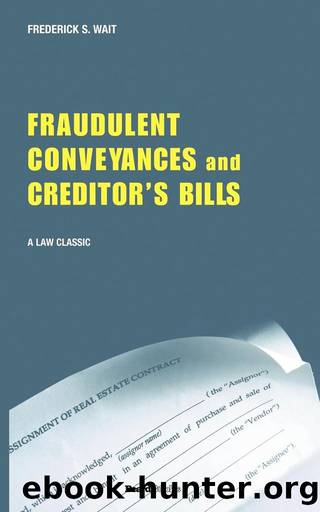A Treatise on Fraudulent Conveyances and Creditors' Bills by FREDERICK S. WAIT

Author:FREDERICK S. WAIT
Language: eng
Format: epub
Publisher: Beard Group
Published: 2018-12-15T00:00:00+00:00
CHAPTER XVI.
INDICIA OR BADGES OF FRAUD.
§ 224. The creditor's embarrassments.âProof of fraud.
225. Badges of fraud defined.
226. Question for the jury.
227. Circumstantial and direct evidence.
228. Recital of fictitious consideration.
229. Antedating instrument.
230. Description of the property.
231. Conveyance of whole estate.
232. Inadequacy of purchase-price.
233. Transfer pending suit.
234. Evidence of secrecy.
§ 235. Suppression or concealment.âSubsequent fraud.
236. Evidence aliunde.
237. Concealment in fraud of bankrupt act.
238. Absolute conveyance by way of security.
239. Insolvency.
240. Sales upon credit.
241. Unusual acts and transactions.
242. Effect of relationship upon debtor's transactions.
243. Prima facie cases of fraud.
244. Comments.
§ 224. The creditor's embarrassments.âProof of fraud.âThe practical difficulties which a creditor encounters in seeking to discover equitable assets, or to reach property fraudulently alienated by the debtor, have already been the subject of comment.1 A transaction or conveyance having every appearance of fairness and legality, and to which the ordinary presumptions of good faith attach,2 is usually presented at the threshold of the litigation. The debtor, and the fraudulent alienees acting in collusion with him, will be found, in most instances, to have taken every precaution to hide the evidences and traces of their frauds, and ordinarily the guilty participants develop into witnesses prolific of plausible statements and ingenious subterfuges devised to uphold the colorable transactions. An intent to defraud is not published to the world, but, on the contrary, the usual course of the participants is to give to the contract the appearance of an honest transaction, and to have the conduct of the interested parties correspond, as far as possible, with a bona fide act.1 Parties practicing fraud almost uniformly resort to expedients to conceal the evidence of it.2 Fraud always takes a tortuous course, and endeavors to cover and conceal its tracks.3 Lord Mansfield said: "Hardly any deed is fraudulent upon the mere face of it." 4 Chief Justice Bricknell observed: "Where a fraud is contemplated and committed upon creditors, concealment of it is the first, and generally the most persistent, effort of those who are engaged in it. Publicity would render their acts vain and useless. Leaving direct and positive evidence accessible to those injured by it, would be the equivalent of a confession of the culpable intent, and of the defeasible character of the transaction. There are numerous circumstances, so frequently attending sales, conveyances and transfers intended to hinder, delay and defraud creditors, that they are known and denominated badges of fraud. They do not constituteâare not elements of fraud, but merely circumstances from which it may be inferred." 5
How, then, can the creditor most effectually thwart the deep laid schemes of the debtor and his fraudulent alienees, and overcome the usual presumptions of honesty and good faith which the parties will invoke? No witness can look into the minds of the parties and thus be able to swear, positively, that they intended to defraud the creditors of the vendor; and hence, as we have already shown in this discussion,6 fraud can generally be established only by facts and circumstances which tend directly or indirectly to indicate its existence.7
Download
This site does not store any files on its server. We only index and link to content provided by other sites. Please contact the content providers to delete copyright contents if any and email us, we'll remove relevant links or contents immediately.
The Social Psychology of Inequality by Unknown(2935)
The Plant Paradox by Dr. Steven R. Gundry M.D(2543)
The Writing on the Wall by Anselm Jappe(2006)
Working for Yourself by J.D. (Nolo) Stephen Fishman(1812)
Every Landlord's Legal Guide by Janet Portman & Stewart Marcia & Ralph Warner(1628)
The First 20 Hours: How to Learn Anything ... Fast by Kaufman Josh(1612)
ADHD on Trial by Michael Gordon(1529)
Decisive by Chip Heath(1512)
Working for Yourself by Stephen Fishman J.D. (Nolo)(1476)
Drafting Contracts: How and Why Lawyers Do What They Do, Second Edition by Stark Tina L(1455)
A Practical Guide to International Arbitration in London by Hilary Heilbron(1393)
Restitution by Restitution(1393)
The Economist Aug 8th 2015 by The Economist(1384)
Intellectual Property Strategy by John Palfrey(1383)
The Lord of the Rings: The Fellowship of the Ring, the Two Towers, the Return of the King by J. R. R. Tolkien(1380)
Get What's Yours for Medicare by Philip Moeller(1358)
The Economist Aug 29th 2015 by The Economist(1342)
Collusion by Luke Harding(1280)
Persuasion by Owner(1265)
